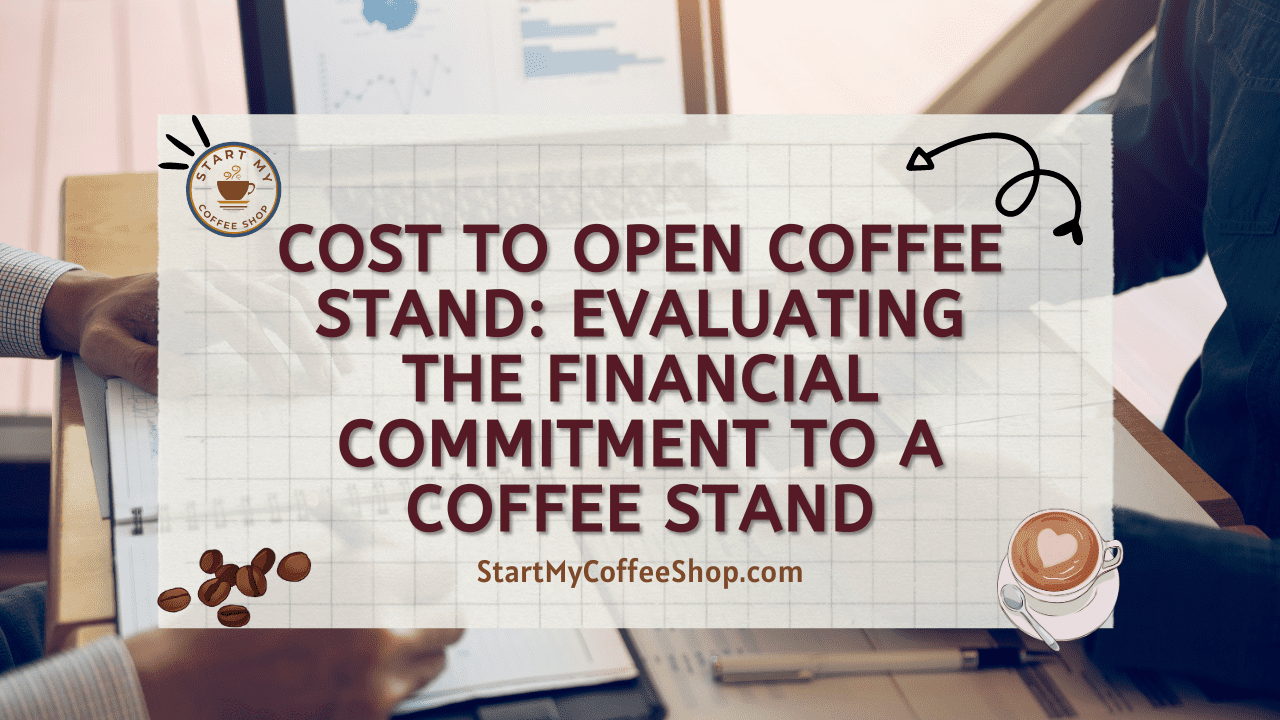Coffee stands have become a ubiquitous sight on street corners and in bustling cities, providing a convenient caffeine fix for busy individuals on the go. If you’ve ever dreamt of opening your coffee stand, it’s crucial to understand the financial aspects involved.
The cost to open a coffee stand can vary depending on factors like location and scale. On average, expect to budget between $20,000 to $100,000 or more for expenses such as rent, equipment, supplies, permits, and marketing efforts.
From equipment and supplies to permits and rent, let’s delve into the world of coffee stand entrepreneurship and explore the cost it takes to turn your java dreams into a reality.
1. Location:
 It is important to note that prime locations often come with a higher price tag. As the demand for the area increases, so does the rental cost. When budgeting for your coffee stand, it’s essential to allocate a portion of your funds to cover the monthly rent expenses.
It is important to note that prime locations often come with a higher price tag. As the demand for the area increases, so does the rental cost. When budgeting for your coffee stand, it’s essential to allocate a portion of your funds to cover the monthly rent expenses.
On average, the rental costs for a coffee stand can range from $500 to $2,000 per month. The specific amount you’ll need to allocate will depend on the city and the specific location you choose. Metropolitan areas and busy downtown districts tend to have higher rental prices, reflecting the increased visibility and foot traffic they offer.
Keep in mind that securing a favorable location goes beyond simply finding a bustling area. Other factors to consider include nearby businesses, competition, parking availability, and accessibility for delivery and supply purposes. Assessing the potential foot traffic, demographics, and target market in the area can also help you gauge the viability of your chosen location.
While it may be tempting to cut costs by opting for a cheaper location, remember that your coffee stand’s visibility and accessibility can play a crucial role in attracting customers. Investing in a prime location with higher rent can yield greater returns in terms of customer volume and revenue.
To make an informed decision, conduct thorough market research and evaluate the pros and cons of various locations. Consider the potential revenue generation, the overall market saturation, and the demographics of the area.
In the competitive world of coffee stands, finding the perfect location is like finding the sweet spot in your brew—a balance of accessibility, visibility, and rental cost. Take your time, crunch the numbers, and make a well-informed decision.
2. Essential Equipment:
When it comes to equipping your coffee stand, selecting the right tools of the trade is crucial for achieving a seamless and high-quality operation. Each piece of equipment plays a vital role in delivering a delicious cup of coffee to your customers, capturing the essence of the coffee experience.
At the heart of your coffee stand, a commercial-grade espresso machine takes center stage. This powerhouse is responsible for extracting rich, aromatic shots of espresso that form the foundation of your beverages.
Investing in a high-quality espresso machine is essential to consistently produce exceptional coffee. Depending on the quality, features, and brand, the cost of an espresso machine can range from $5,000 to $20,000 or even more.
Next on the list is a grinder. A reliable coffee grinder is indispensable for achieving the desired grind consistency, which directly impacts the quality of the extraction and flavor in each cup.
Investing in a high-quality grinder ensures that you can consistently deliver the perfect grind. The price of a grinder varies depending on the quality and features you desire, ranging from a few hundred to a couple of thousand dollars.
Refrigeration units are essential for storing perishable ingredients such as milk and syrups at the optimal temperature, ensuring freshness and maintaining flavor. The size and specific needs of your coffee stand will determine the number and size of refrigeration units required. The cost of refrigeration equipment typically ranges from a few hundred to a couple of thousand dollars.
To handle transactions smoothly and efficiently, a robust point-of-sale (POS) system is crucial. A modern POS system helps you manage orders, track sales, and handle payments seamlessly.
The cost of a POS system varies depending on the features and complexity you require. Basic systems can start at a few hundred dollars, while more advanced setups with additional functionalities can be higher in cost.
In addition to these core equipment items, there are other essentials to consider. Coffee brewers, water filtration systems, blenders, and storage containers all contribute to the functionality and efficiency of your coffee stand.
While their costs may be relatively lower compared to the espresso machine or grinder, they are integral to the overall operation and should be factored into your budget.
When budgeting for equipment, it’s important to strike a balance between quality and cost. While it may be tempting to opt for cheaper alternatives, investing in durable and reliable equipment will save you money in the long run by reducing maintenance and replacement costs. Consider your projected customer volume, menu offerings, and long-term growth plans when making equipment decisions.
Research reputable brands, read customer reviews, and consult with industry professionals to make informed choices. It’s also worth considering warranties, after-sales support, and training options from equipment manufacturers or suppliers.
Equipping your coffee stand with the necessary tools of the trade can require an initial investment ranging from $5,000 to $20,000 or more, depending on the quality, brand, and specific needs of your business.
These tools are the backbone of your operation, ensuring that each cup of coffee served is a testament to your commitment to excellence and an exceptional experience for your customers.
Read more about Best Grinder Coffee Maker: Elevating Your Coffee Experience
3. Supplies and Inventory:
To keep your coffee stand operating smoothly, it’s essential to factor in the cost of supplies and inventory. These are the tangible items that make up the backbone of your business, ensuring that you can meet the demands of your customers and provide them with an exceptional coffee experience.
Supplies and inventory encompass a wide range of items, including coffee beans, milk, syrups, cups, lids, napkins, stirrers, and other consumables that are necessary for the day-to-day operations of your coffee stand.
The specific costs associated with these items can vary depending on several factors, such as the volume of customers you anticipate serving and the variety of offerings you plan to provide.
One of the primary expenses you’ll encounter is the cost of coffee beans. The quality and source of the beans can greatly impact the taste and overall experience of your coffee. It’s worth investing in high-quality beans to ensure customer satisfaction.
The price of coffee beans can vary depending on the type, origin, and supplier, but it’s important to allocate a portion of your budget to cover this essential ingredient.
Milk and syrups are also crucial components of many popular coffee beverages. The cost of milk will depend on the type and quantity you choose to offer, whether it’s dairy or non-dairy alternatives. Syrups come in various flavors and can add an extra touch of sweetness or flavor to your drinks. These costs will depend on the variety and brand you select.
Additionally, consider the expenses associated with cups, lids, napkins, and stirrers. These items are necessary for serving your beverages and providing a convenient and enjoyable experience for your customers. The cost will depend on the quantity and quality of the supplies you choose to stock.
The monthly expenses for supplies and inventory can range from $500 to $1,500 on average. This estimation takes into account the typical needs of a coffee stand operation. However, it’s important to note that this figure can vary based on factors such as the size of your customer base, the seasonality of demand, and any specific requirements or offerings unique to your business.
To manage these costs effectively, it’s advisable to closely monitor your inventory levels, track usage patterns, and establish relationships with reliable suppliers who can offer competitive pricing.
Consider factors such as shelf life, storage requirements, and ordering lead times to ensure you always have the necessary supplies on hand without incurring excessive waste or running out of key items.
By keeping a careful eye on your supplies and inventory, you can strike a balance between meeting customer demands and controlling expenses. This will contribute to the overall efficiency and profitability of your coffee stand.
4. Licensing and Permits:
Operating a coffee stand involves more than just serving up delicious beverages. It also requires compliance with local regulations and obtaining the necessary licenses and permits. Ensuring that you have the proper documentation and approvals in place is essential for running your business legally and maintaining the trust and safety of your customers.
The specific licenses and permits you’ll need can vary depending on your location and the specific requirements set forth by your local government or regulatory bodies. Some common licenses and permits required for operating a coffee stand include health department permits, food handling certifications, and general business licenses.
Health department permits are crucial as they ensure that your coffee stand meets the required health and safety standards. These permits typically involve inspections of your facility, equipment, and overall cleanliness to ensure that you are adhering to proper sanitation practices.
The cost of health department permits can vary depending on the jurisdiction and the specific requirements, ranging from a few hundred to a couple of thousand dollars.
Food handling certifications are another important aspect of operating a coffee stand. These certifications demonstrate that you and your staff have received the necessary training in food safety and handling practices. The cost of obtaining food handling certifications can vary, but it’s advisable to allocate funds for training courses and examination fees.
In addition to health-related permits and certifications, you may also need a general business license. This license ensures that your coffee stand is operating within the legal framework of your local jurisdiction.
The cost of a business license can vary depending on factors such as your location and the size of your operation. It’s important to research and understand the specific requirements and associated costs in your area.
When budgeting for licensing and permits, it’s advisable to allocate funds ranging from $500 to $2,000. This estimation takes into account the potential costs associated with obtaining the necessary licenses and permits for a coffee stand operation.
However, it’s important to note that these figures are approximate and can vary based on factors such as your location, the specific permits required, and any additional fees or inspections.
To ensure compliance and a smooth licensing process, it’s recommended to reach out to your local government agencies or regulatory bodies to understand the specific requirements for operating a coffee stand in your area. This will help you navigate the application process, understand the associated costs, and ensure that you have all the necessary documentation in place.
5. Marketing and Branding:
One of the first steps in marketing your coffee stand is developing eye-catching and memorable signage. A well-designed sign can attract attention and communicate the essence of your brand to passersby.
Whether it’s a colorful storefront sign, chalkboard menu, or window decals, allocating a portion of your budget to signage is a worthwhile investment. Depending on the size, complexity, and materials used, sign costs can range from a few hundred to a couple of thousand dollars.
Flyers and printed materials are another effective way to reach potential customers. Distributing flyers in nearby neighborhoods, local businesses, or community bulletin boards can help spread the word about your coffee stand. Printing costs will vary based on the quantity and design complexity, but it’s advisable to set aside a budget for these marketing materials.
In today’s digital age, utilizing social media platforms is crucial for marketing your coffee stand. Creating engaging content, sharing photos of your drinks, and interacting with your audience can help build an online presence and attract customers. Consider allocating funds for social media advertising to reach a wider audience and boost brand visibility. Depending on your target audience and the duration of your campaigns, costs can range from a few hundred to a couple of thousand dollars.
Promotional events and collaborations can also be effective marketing strategies. Partnering with local businesses or participating in community events can expose your coffee stand to a wider audience.
Consider sponsoring or hosting events, offering discounts or promotions, or partnering with influencers or local organizations to generate buzz and attract customers. The cost of promotional events can vary depending on the scale and scope of the event, but allocating a budget for these activities can yield positive results.
When budgeting for marketing efforts, it’s recommended to allocate between $500 to $2,000 initially, depending on the scale of your campaign and the specific strategies you choose to implement. It’s important to note that marketing is an ongoing effort, and additional funds may be required for future campaigns and promotions.
It’s also important to track and measure the effectiveness of your marketing efforts. Analyze customer feedback, monitor social media engagement, and track foot traffic to assess the return on investment (ROI) of your marketing activities. This will help you refine your strategies and allocate resources more effectively in the future.
Read more about Best Nespresso Coffee Machine: Discovering the Best Nespresso Coffee Machine on the Market
6. Staffing and Training:
 As the popularity of your coffee stand grows and the demand for your beverages increases, you may find it necessary to hire additional staff members to keep up with the pace. The cost of employee wages and training should be carefully considered and factored into your budget to ensure the smooth and efficient operation of your coffee stand.
As the popularity of your coffee stand grows and the demand for your beverages increases, you may find it necessary to hire additional staff members to keep up with the pace. The cost of employee wages and training should be carefully considered and factored into your budget to ensure the smooth and efficient operation of your coffee stand.
Determining the number of employees you’ll need will depend on various factors, such as the size of your coffee stand, the volume of customers you anticipate serving, and the complexity of your menu offerings. Assess the different roles required, including baristas, cashiers, and support staff, and determine the appropriate staffing levels to meet the demands of your business.
When setting hourly rates for your employees, it’s important to consider both industry standards and the local labor market. Research the prevailing wages for similar positions in your area to ensure that you can attract and retain talented individuals. The level of experience and skill required for each role may also influence the hourly rates you offer.
In addition to wages, you should also allocate funds for employee training. Properly training your staff is essential for maintaining consistent quality, customer service, and adherence to your coffee stand’s standards and procedures. Consider the costs associated with initial training programs, ongoing skill development, and any certifications or courses required for specialized roles.
When budgeting for staffing costs, it’s advisable to allocate between $1,500 to $5,000 per month, depending on the number of employees, their hourly rates, and training expenses. This range allows for flexibility based on the size and complexity of your operation.
It’s worth noting that staffing costs can fluctuate depending on factors such as the seasonality of your business, employee turnover rates, and any additional benefits or incentives you offer. Regularly review your staffing needs and adjust your budget accordingly to ensure that you have the necessary resources to support your team.
7. Unexpected Expenses and Contingencies:
When operating a coffee stand, it’s important to prepare for the unexpected and have a financial cushion to handle unforeseen expenses. Despite careful planning and budgeting, certain factors can impact your bottom lines, such as equipment repairs, maintenance costs, and fluctuations in supply prices. By allocating a portion of your budget for contingencies, you can mitigate the impact of these unexpected expenses.
One potential area of unforeseen expenses is equipment repairs. Over time, even the most reliable and well-maintained equipment may require repairs or replacement parts. Factors such as wear and tear, electrical issues, or unforeseen malfunctions can occur, causing disruptions to your operations.
It’s advisable to set aside funds to cover these unexpected repair costs, ensuring that you can promptly address any equipment issues without compromising the quality of your service or incurring significant downtime.
Another aspect to consider is maintenance costs. Regular maintenance is essential for keeping your coffee stand running smoothly and preventing major breakdowns. This includes tasks such as cleaning, servicing, and inspecting your equipment, as well as maintaining the overall cleanliness and functionality of your establishment.
While routine maintenance is a planned expense, there may be unforeseen maintenance needs that arise unexpectedly. By allocating a portion of your budget to cover these unexpected maintenance costs, you can ensure that your coffee stand remains in optimal condition and minimize the risk of operational disruptions.
Fluctuations in supply prices can also impact your budget. The cost of coffee beans, milk, and other essential ingredients can vary due to factors such as changes in market conditions, weather patterns affecting crop yields, or transportation costs. These fluctuations can impact your profit margins if you are not prepared. By setting aside a portion of your budget to account for potential price increases, you can adapt to these changes and maintain the stability of your financials.
To provide a buffer for unexpected expenses, it’s advisable to allocate around 10-15% of your total budget for contingencies. This allocation allows you to have a financial cushion to handle unforeseen circumstances without significantly affecting your overall operations. However, it’s important to periodically review and reassess this allocation based on the specific needs and challenges of your coffee stand.
Summary
Opening a coffee stand is an exciting venture that comes with its fair share of costs. From securing the right location to investing in equipment, supplies, permits, and marketing efforts, careful financial planning is vital.
While the overall cost to open a coffee stand can vary depending on factors such as location and scale of operations, a rough estimate would be between $20,000 to $100,000 or more. By understanding these expenses and budgeting wisely, you can embark on your coffee stand journey with confidence, ready to serve up delicious cups of java to your customers.
Frequently Asked Questions
Question #1: What are the ongoing expenses of running a coffee stand?
Monthly costs for supplies and inventory can range from $500 to $1,500, while staffing expenses may vary between $1,500 and $5,000, depending on the number of employees.
Question #2: Do I need any special permits or licenses to operate a coffee stand?
Yes, working a coffee stand typically requires obtaining various permits and licenses, such as health department permits, food handling certifications, and local business licenses.
Question #3: How long does it take to set up a coffee stand?
On average, it can take anywhere from a few weeks to several months to complete the setup process.
To learn more on how to start your own coffee shop checkout my startup documents here
Please note: This blog post is for educational purposes only and does not constitute legal advice. Please consult a legal expert to address your specific needs.

Hi! I’m Shawn Chun
My adventure in coffee began when I first launched my first coffee shop back in the early 2000s. I had to figure out so many things on my own and to make it worse within 2 years of opening two large corporate coffee chains moved in just blocks away from me!
As I saw smaller and even some larger coffee shops in the neighborhood slowly lose customers to these giant coffee chains and slowly close up shop, I knew that I had to start getting creative…or go out of business.
I (like you may be) knew the coffee industry well. I could make the best latte art around and the foam on my caps was the fluffiest you have ever seen. I even had the best state-of-the-art 2 group digital Nuova Simonelli machine money could buy. But I knew that these things alone would not be enough to lure customers away from the name brand established coffee shops.
Eventually, through lots of trial and error as well as perseverance and creativity I did find a way to not only survive but also thrive in the coffee/espresso industry even while those corporate coffee chains stayed put. During those years I learned to adapt and always faced new challenges. It was not always easy, however, in the end, I was the sole survivor independent coffee shop within a 10-mile radius of my location. Just two corporate coffee chains and I were left after that year. All told the corporate coffee chains took down over 15 small independent coffee shops and kiosks and I was the last one standing and thriving.
Along the years I meet others with the same passion for coffee and I quickly learned that it is not only “how good a barista is” that makes a coffee shop successful, but the business side of coffee as well.
Hence why I started this website you are on now. To provide the tools and resources for up and coming coffee shop owners to gain that vital insight and knowledge on how to start a coffee shop successfully.
Stick around, browse through my helpful blog and resources and enjoy your stay! With lots of LATTE LOVE!
Shawn






